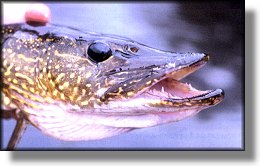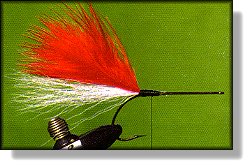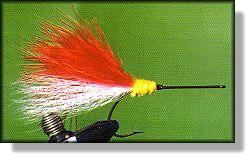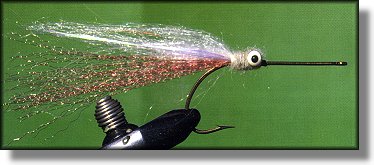The Brochet - Great Canadian Flies
By Sheldon Seale
Fly Fishing has generally been associated with trout and salmon fishing.
This popular but misconceived notion is commonplace among non-fly fishers and
the general populace. However, nothing could be further from the truth.
 One of fresh water's most challenging species for fly fishing is the Northern Pike of
North America, Europe and northern Asia. The Pike goes by many names including
Northern, Jack, Lance and Snake, and lives up to its Latin name, Esox lucius,
'water wolf'. No creature from land, air or water small enough (maybe) to fit into its
mouth is safe from a Pike. Their attack is fast, ferocious, and frequently enough ends
up with the Pike getting a meal (or at least part of one).
One of fresh water's most challenging species for fly fishing is the Northern Pike of
North America, Europe and northern Asia. The Pike goes by many names including
Northern, Jack, Lance and Snake, and lives up to its Latin name, Esox lucius,
'water wolf'. No creature from land, air or water small enough (maybe) to fit into its
mouth is safe from a Pike. Their attack is fast, ferocious, and frequently enough ends
up with the Pike getting a meal (or at least part of one).
Like the Shark, a Pike is a predatory machine, designed by nature to rule its fresh water
haunts. It regularly exceeds 10 kilos (22 pounds) in weight and 1 metre (39 inches) in
length. One look tells a careful observer why a Pike has such a formidable ability to
wreak havoc among the smaller denizens of lake or river (and, as we have found, even
small trout streams like my own beloved Credit River). It has a long, lean structure
with large fins designed for speed. It is well camouflaged for ambushing or stalking
its prey. That it is a sight feeder is obvious. It has both eyes situated on the front of
its face for excellent binocular vision. They are also situated to look somewhat upwards
and Pike will often take food from the surface. I have regularly witnessed the demise
of Mallard ducklings in good pike water.
Being a sight hunter and displaying some willingness to take food from the surface,
one would expect that the Pike would be a natural target of the fly fisher. There is,
however, one small problem or, more correctly, a mouthful of problems and some
of them aren't small! I am referring, of course, to the dentition found in those jaws.
I've been bitten on the hand by a Pike (fortunately, a fairly small one). I have
experienced first hand both the effectiveness of those teeth and that a Pike has an
anticoagulant in its saliva. I had some concerns about stopping the bleeding. Those
teeth, however, are equally effective at parting tippet and, if the Pike is a large one,
30 or 40 pound tippet may not be enough.
But, what a Pike can do to your fly is devastating! Pike are sometimes referred to
as 'one fly' fish, not because there is only one fly that they will take, but because a
fly rarely survives more than one Pike! Nevertheless, Pike can be caught by fly
fishers if they are equipped correctly and have appropriately designed and tied flies.
From the perspective of the fly, what are some of the characteristics required for it
to be effective?
1. It must be lively in water.
2. It should pulse and/or dip seductively and should work well when moved slowly.
3. It must be durable.
4. It should be easy and quick to tie, from readily available and, preferably, inexpensive materials.
5. It should easily adapt to some form of shock tippet (either wire or heavy monofilament).
The Brochet
Back in 1988, Bill Dousett and Jaques Juneau, from one of Canada's pike hotspots- the
Province of Quebec, attended the Canadian Fly Fishing Forum and conducted seminars
on Pike fishing. In an article for the 1998 Forum edition of the Izaak Walton Fly Fishers'
Club magazine, Double Haul, they describe a generic Pike fly pattern,
without actually giving it a name. This pattern incorporates all the desired characteristics
identified above. In this article, I have chosen to name this pattern the 'Brochet' in honour
of Dousett and Juneau, and the province of Quebec where the popular French word for
Pike is 'brochet'.
The pattern, in its original form, borrowed heavily from some salt water patterns in that
it is tied on the back part of a large-gaped, extra-long, ring-eyed hook. It can be tied
weedless or not. It calls for basic, simple-to-get, all-natural materials.
The original pattern
Hook size 2-4 6X long, wide gape, ring eyed hook
Thread Black 3/0
Tail Bucktail (dyed)
Wing Marabou (dyed)
Body Chenille
Tying Instructions

Step 1 Start your thread just forward of the hook point and lay down
a bed of thread for about 1 cm. or so. Cut a bunch of bucktail fibres and even the tips
a little (it isn't necessary to overdo this step, the Pike won't mind). Trim the bucktail
to length and put a little glue or head cement on the butts, working it into the fibres.
Secure the bucktail with very tight wraps of thread. By tapering the butts a little,
a nice neat tie in can be made. The glue or head cement will add to the durability.
Step 2 Add a wing of marabou to the fly right on top of the thread
wraps of the tail. The wing should extend back to the end of the tail. Glue or head
cement can be used to improve durability, but marabou generally does not pull out
as easily as bucktail does.

Step 3 Strip some of the chenille to reveal the inner core. Tie in the
chenille by the exposed threads right at the base of the wing and wind forward over
the thread wraps. Secure the chenille with a couple of wraps of thread, trim the excess
and form a small, neat head of thread. Coat the head with lacquer and the fly is finished.
Finally, a short word on fly colour. Try the infamous Red and White combination, but
don't overlook Red and Yellow, Black and Yellow, all Red, all Yellow, all Black, all
Chartreuse or any other bright colour you like. Some days, Blue and White are effective.
Tie up a bunch of different combinations and let us know how you do (and under
what conditions of weather and water).
|
Since Dousett and Juneau developed the Brochet Fly, many effective artificial
materials have come into general use. Incorporating these materials into the pattern
has increased the survivability of the fly considerably. Indeed, whereas an original pattern
might last for 3 or 4 good-sized Pike, the artificial materials based patterns hold up for
10 or more fish.
Hook size 2-4 6X long, wide gape, ring eyed hook
Thread Black 3/0
Eyes Large, painted lead eyes (optional)
Tail Ultra Hair or similar, assorted colours
Wing Synthetic Fur, assorted colours and a couple of
strands of pearlescent Flashabou on each side
Body Chenille or yarn or dubbing - especially
synthetics. |

Fishing Instruction
There is no wrong way to fish this fly. Just chuck it out and strip it back. Vary your
retrieve to get as much action as possible. If you see a wake or a fish behind your line,
try stripping faster (as if the fly were trying to evade capture). Use a stout leader and
be especially careful when lifting the fly from the water. Pike are notorious about following
your fly and striking savagely as you lift the fly out. The angler generally overreacts, strikes
far too hard and either parts company with and/or breaks his rod (either on the strike
or on the hard pull back the Pike will make). Be especially careful of the gunwale if
fishing from a boat or canoe. More rods are broken over gunwales than in doors!!!

Speaking about leaders, its a very good idea to incorporate a shock tippet in your leader.
This can be made of 12 to 18 kilogram (30 to 40 pound) breaking strength monofilament
or some gel-coated, braided steel wire. You can connect the fly to the shock tippet using
a Duncan Loop or Uni-knot and connect the shock tippet to the leader with a double
Uni-knot. This has proven very effective and still allows you to change flies. Start with
30-50 cm. of shock tippet and replace it when its about 15 cm.
~ Sheldon Seale
|




 One of fresh water's most challenging species for fly fishing is the Northern Pike of
North America, Europe and northern Asia. The Pike goes by many names including
Northern, Jack, Lance and Snake, and lives up to its Latin name, Esox lucius,
'water wolf'. No creature from land, air or water small enough (maybe) to fit into its
mouth is safe from a Pike. Their attack is fast, ferocious, and frequently enough ends
up with the Pike getting a meal (or at least part of one).
One of fresh water's most challenging species for fly fishing is the Northern Pike of
North America, Europe and northern Asia. The Pike goes by many names including
Northern, Jack, Lance and Snake, and lives up to its Latin name, Esox lucius,
'water wolf'. No creature from land, air or water small enough (maybe) to fit into its
mouth is safe from a Pike. Their attack is fast, ferocious, and frequently enough ends
up with the Pike getting a meal (or at least part of one).
